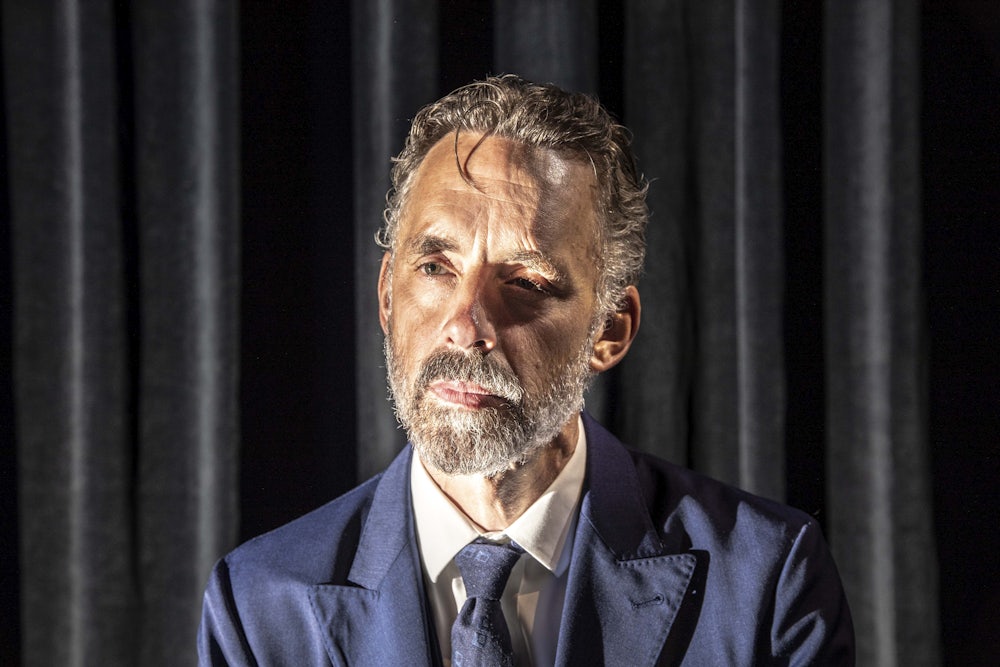The Canadian psychology professor Jordan
Peterson has been described as “the
most influential public intellectual in the Western world.” He is an exponent of the Jungian concept of the hero’s journey, in which
an ordinary person heeds a call to adventure and goes out into the world to
struggle and suffer, only to return with heightened self-knowledge. (He has
described himself, without apparent irony, as being “raised and toughened in the frigid wastelands of Northern Alberta.”)
His stern ethos of self-help and bootstrapping has made him a darling of the
so-called intellectual dark web, and a gateway drug for countless budding
right-wingers who have stumbled upon one of his lectures on YouTube.
So it was something of a surprise to learn, in early February, that Peterson had spent eight days in a medically induced coma at an unnamed clinic in Russia. Peterson’s daughter Mikhaila, a 28-year-old food blogger, posted a brief but dramatic video claiming that she and her father had traveled to Russia in early January seeking an unorthodox treatment for his physical dependence on the drug clonazepam. Dependency goes against the core tenets of Peterson’s philosophical brand: stoicism, self-reliance, the power of the will over circumstance and environment. “No one gets away with anything, ever, so take responsibility for your own life,” he admonished in his bestselling self-help book 12 Rules for Life.
According to Mikhaila, he nearly died several times during his medical ordeal. After weeks in intensive care, he was unable to speak or write and was taking anti-seizure medicine.
The news was met with bafflement by doctors and laypeople alike. What was Peterson doing in a drug-induced coma in Russia? Based on interviews with medical professionals and a close reading of various statements that Mikhaila and Peterson himself have made on podcasts and social media, it is clear that Peterson ended up in Russia after an extended battle to wean himself off clonazepam. And it seems likely that Peterson, a self-proclaimed man of science, succumbed to the lure of a quack treatment—with devastating consequences.
Peterson’s saga has mostly been covered in conservative news outlets, which have relied almost exclusively on a disjointed narrative put forth by Mikhaila, a nutrition “influencer” with no medical credentials who claims to have cured her idiopathic juvenile arthritis, clinical depression, and a C. difficile infection by eating nothing but meat, salt, and water. Peterson promoted his daughter’s snake oil diet and even embraced the program himself. In July 2018, he told celebrity podcaster Joe Rogan that he’d been eating nothing but beef, salt, and water for two months at his daughter’s suggestion, following a year of eating almost nothing but steak and salad. It’s unclear whether Peterson continued to follow this extreme diet.
Peterson’s health problems first surfaced in September 2019, when his family announced that he had undergone a stint in rehab in upstate New York. According to Mikhaila’s update from Russia, he was prescribed the sedative clonazepam, a benzodiazepine, by his family doctor in 2017 for anxiety stemming from a “severe autoimmune reaction to food.” Peterson’s doctor allegedly increased his dose after Peterson’s wife was diagnosed with kidney cancer in April 2019. Peterson supposedly didn’t realize he’d become dependent on clonazepam until he suffered agonizing withdrawal symptoms when he tried to quit the medication cold turkey during the summer of 2019.
Mikhaila has consistently and emphatically claimed that her father is suffering strictly from physical dependence, and not from addiction. And it is important to stress that the two are distinct. Dependence simply means that a person gets withdrawal symptoms when they stop taking a drug. The National Institute on Drug Abuse defines addiction as “compulsive use despite harmful consequences.” It is possible to be dependent on a drug without being addicted to it.
Media reports have claimed that Peterson is suffering from addiction, but have offered no evidence to support the claim. If Peterson were addicted, you’d expect see signs of loss of control over his drug use, which might include buying drugs on the street; “doctor-shopping”; unauthorized dose increases; and drug-related problems with work, family, or the law.
So far, there is no evidence that Peterson displayed any of the so-called “aberrant behaviors” that define addiction. But again, all we have to go on is reports from his daughter, whose family has a strong financial incentive to spin away any suggestion that the man who made his name engaging in a kind of intellectual Spartan cosplay is hopelessly addicted to a sedative. In fact, Mikhaila has jokingly alluded to how bad an addiction diagnosis would be for her father’s lucrative self-help brand, which purports to rid adherents of weakness through grit and self-sacrifice. “We figured we should let people know [the facts] before some tabloid finds out and publishes [that] Jordan Peterson, ‘self help guru,’ is on meth or something,” Mikhaila said in a video update after Peterson checked himself into rehab in the U.S.
Still, as soon as Peterson’s initial stint in rehab became public in 2019, threads sprang up in Peterson-related forums about whether his fans should think less of him in light of his struggles with benzodiazepines. “He was using a drug to escape the pain of reality, period. Call it whatever you like, but it doesn’t change the facts,” wrote the user KingLudwigII on Reddit. In fact, dependence and addiction are health issues, not character defects, and if you pressed Peterson on that point, he’d probably agree. However, that message is a tough sell to many of Peterson’s fans, who are drawn to his macho image and his personal story of triumph over adversity.
By August or September 2019, Peterson’s health had deteriorated to the point that the family was more worried about him than his cancer-stricken wife, Mikhaila said in an appearance on RT, the Russian propaganda network aimed at audiences outside of Russia.
There are established ways of treating a dependence on benzodiazepines, a class of sedatives—including Klonopin (clonazepam), Valium (diazepam), and Xanax (alprazolam)—used for anxiety, insomnia, and epilepsy. Introduced to the U.S. market in 1960 as an alternative to barbiturates, benzodiazepines can be useful in treating a variety of conditions from panic attacks to muscle spasms. They can be very helpful for short-term and intermittent use, but their benefits tend to wane when they are used every day. They can also cause physical dependence within four weeks. If a person who’s physically dependent on benzodiazepines stops taking the drugs suddenly, they can suffer from withdrawal symptoms including severe anxiety, agitation, and even life-threatening seizures.
Dr. Olivera Bogunovic, the medical director of ambulatory services at Boston’s McLean Hospital and an assistant professor of psychiatry at Harvard Medical School, developed an outpatient program to wean patients off benzodiazepines almost a decade ago. Prior to that, she recalls, patients were being detoxed over four days in the hospital, because that was all insurance would pay for. Four days is a very rapid detox, and it sometimes resulted in the patients having seizures.
The state-of-the-art treatment for benzodiazepine dependence is not some grueling ordeal. Patients aren’t strapped to a hospital bed, white-knuckling it through withdrawal; instead, they are gradually weaned off the drugs outside the hospital over the course of months. In general, doctors try to decrease a patient’s dose by 25 percent every two weeks. Bogunovic reports that this method has a very high success rate: “Up to 80 to 90 percent of patients have successfully completed detox in our clinic,” she told me.
Jordan reportedly unsuccessfully attempted to quit cold turkey at least once on his own, which may have set him up for future problems. “It’s called the kindling effect,” Bogunovic explained. “If you don’t detox properly the first time, every subsequent detox can be more difficult.”
Mikhaila also claims that, in addition to his dependence on clonazepam, Jordan suffered from a paradoxical reaction to the drug, which allegedly made him extremely restless. (A sedative, of course, is meant to have the exact opposite effect.) Bogunovic says that such paradoxical reactions to benzodiazepines occur in about 1–2 percent of patients. The clinical term is akathisia. The patient may shift positions, cross and uncross their legs, rock, or writhe. A severe case of akathisia can make a person completely unable to function.
The picture that emerges is of a man who was trapped: He couldn’t tolerate the medication, and he couldn’t tolerate the withdrawal. Mikhaila told RT that her father was looking for a place that had the guts to detox him “cold turkey,” a place where doctors “aren’t influenced by the pharmaceutical companies.”
Apparently that’s how a man who didn’t want to use drugs traveled thousands of miles to be placed in a drug-induced coma. Mikhaila said that her father was diagnosed with pneumonia “upon arrival” in Russia. If that’s accurate, then his medically induced coma may have had nothing to do with benzodiazepine withdrawal. If pneumonia is so severe that it causes respiratory failure, the patient needs to go on a ventilator simply to breathe. Because it’s so unpleasant to be on a breathing machine in an intensive care unit, patients are usually heavily sedated.
The more alarming possibility is that Peterson was placed in a coma as part of his detox regimen. Mikhaila described her father’s treatment as “an emergency medical benzodiazepine detox, which we were only able to find in Russia.” The term “medical detox” suggests that drugs were an integral part of the program, and the fact that this treatment is only available in Russia implies that it wasn’t one of the more conservative forms of drug-assisted detox available in North America.
Bogunovic says she’s heard of people using medically induced comas to treat benzodiazepine withdrawal, but that it’s extremely rare and not scientifically sound. It’s a little more common to offer this kind of sedation for opioid withdrawal, she says, but there’s no evidence to support the efficacy or safety of sedation detox for opioids, either. The problem, Bogunovic says, is that the patient still has to cope with withdrawal symptoms after they wake up. And the risks of being sedated and placed on a ventilator alone are considerable: Ventilators can cause pneumonia, and prolonged immobility puts patients at risk of blood clots, which can cause strokes.
Another possibility is that Peterson’s doctors didn’t set out to put him in a coma, but that he developed such severe withdrawal symptoms from quitting “cold turkey” that they were forced to do so for his own protection. Sometimes, in cases of severe benzodiazepine withdrawal, the patient becomes so agitated that they have to be sedated; their heart rate and blood pressure can skyrocket, and their extreme agitation can make them a danger to themselves and the medical team.
Seizures are by far the most feared side effect of sudden abstinence from benzos. If someone vomits during a seizure and inhales the vomit, they can stop breathing or develop pneumonia, either of which could have landed Peterson in a coma.
Mikhaila blames Western medicine for her father’s predicament, and not just because Western doctors prescribed the pills. Allegedly, Peterson’s pneumonia was the fault of a North American hospital, too, though she doesn’t say how she knows that. Mikhaila is essentially weaving her own “hero’s journey” into her father’s ordeal, one in which she brought him to a far-flung clinic that had “the guts” to do what Western doctors wouldn’t. It’s a tale that burnishes her brand as a wellness influencer and shoves aside awkward questions about whether the treatment harmed Peterson.
When it comes to recovery, there are no quick fixes. But that doesn’t mean the most arduous option is necessarily the most effective. If Peterson’s sad story has a moral, it’s that a drug problem is neither a dragon to be slain nor a sin to be ashamed of. It’s a mundane health problem that should be treated scientifically, without heroics.




